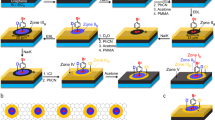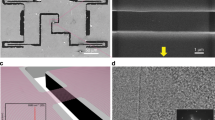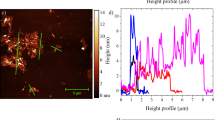Abstract
Graphene, a single atomic layer of carbon connected by sp2 hybridized bonds, has attracted intense scientific interest since its recent discovery1. Much of the research on graphene has been directed towards exploration of its novel electronic properties, but the structural aspects of this model two-dimensional system are also of great interest and importance. In particular, microscopic corrugations have been observed on all suspended2 and supported3,4,5,6,7,8 graphene sheets studied so far. This rippling has been invoked to explain the thermodynamic stability of free-standing graphene sheets9. Many distinctive electronic10,11,12 and chemical13,14,15 properties of graphene have been attributed to the presence of ripples, which are also predicted to give rise to new physical phenomena16,17,18,19,20,21,22,23,24,25,26 that would be absent in a planar two-dimensional material. Direct experimental study of such novel ripple physics has, however, been hindered by the lack of flat graphene layers. Here we demonstrate the fabrication of graphene monolayers that are flat down to the atomic level. These samples are produced by deposition on the atomically flat terraces of cleaved mica surfaces. The apparent height variation in the graphene layers observed by high-resolution atomic force microscopy (AFM) is less than 25 picometres, indicating the suppression of any existing intrinsic ripples in graphene. The availability of such ultraflat samples will permit rigorous testing of the impact of ripples on various physical and chemical properties of graphene.
This is a preview of subscription content, access via your institution
Access options
Subscribe to this journal
Receive 51 print issues and online access
$199.00 per year
only $3.90 per issue
Buy this article
- Purchase on Springer Link
- Instant access to full article PDF
Prices may be subject to local taxes which are calculated during checkout


Similar content being viewed by others
References
Novoselov, K. S. et al. Two-dimensional atomic crystals. Proc. Natl Acad. Sci. USA 102, 10451–10453 (2005)
Meyer, J. C. et al. The structure of suspended graphene sheets. Nature 446, 60–63 (2007)
Stolyarova, E. et al. High-resolution scanning tunneling microscopy imaging of mesoscopic graphene sheets on an insulating surface. Proc. Natl Acad. Sci. USA 104, 9209–9212 (2007)
Ishigami, M., Chen, J. H., Cullen, W. G., Fuhrer, M. S. & Williams, E. D. Atomic structure of graphene on SiO2 . Nano Lett. 7, 1643–1648 (2007)
Booth, T. J. et al. Macroscopic graphene membranes and their extraordinary stiffness. Nano Lett. 8, 2442–2446 (2008)
Knox, K. R. et al. Spectromicroscopy of single and multilayer graphene supported by a weakly interacting substrate. Phys. Rev. B 78, 201408 (2008)
Stoberl, U., Wurstbauer, U., Wegscheider, W., Weiss, D. & Eroms, J. Morphology and flexibility of graphene and few-layer graphene on various substrates. Appl. Phys. Lett. 93, 051906 (2008)
Geringer, V. et al. Intrinsic and extrinsic corrugation of monolayer graphene deposited on SiO2 . Phys. Rev. Lett. 102, 076102 (2009)
Fasolino, A., Los, J. H. & Katsnelson, M. I. Intrinsic ripples in graphene. Nature Mater. 6, 858–861 (2007)
Morozov, S. V. et al. Strong suppression of weak localization in graphene. Phys. Rev. Lett. 97, 016801 (2006)
Martin, J. et al. Observation of electron-hole puddles in graphene using a scanning single-electron transistor. Nature Phys. 4, 144–148 (2008)
Deshpande, A., Bao, W., Miao, F., Lau, C. N. & LeRoy, B. J. Spatially resolved spectroscopy of monolayer graphene on SiO2 . Phys. Rev. B 79, 205411 (2009)
Liu, L. et al. Graphene oxidation: thickness-dependent etching and strong chemical doping. Nano Lett. 8, 1965–1970 (2008)
Ryu, S. et al. Reversible basal plane hydrogenation of graphene. Nano Lett. 8, 4597–4602 (2008)
Elias, D. C. et al. Control of graphene's properties by reversible hydrogenation: evidence for graphane. Science 323, 610–613 (2009)
Huertas-Hernando, D., Guinea, F. & Brataas, A. Spin-orbit coupling in curved graphene, fullerenes, nanotubes, and nanotube caps. Phys. Rev. B 74, 155426 (2006)
de Juan, F., Cortijo, A. & Vozmediano, M. A. H. Charge inhomogeneities due to smooth ripples in graphene sheets. Phys. Rev. B 76, 165409 (2007)
Brey, L. & Palacios, J. J. Exchange-induced charge inhomogeneities in rippled neutral graphene. Phys. Rev. B 77, 041403 (2008)
Guinea, F., Horovitz, B. & Le Doussal, P. Gauge field induced by ripples in graphene. Phys. Rev. B 77, 205421 (2008)
Guinea, F., Katsnelson, M. I. & Vozmediano, M. A. H. Midgap states and charge inhomogeneities in corrugated graphene. Phys. Rev. B 77, 075422 (2008)
Herbut, I. F., Juricic, V. & Vafek, O. Coulomb interaction, ripples, and the minimal conductivity of graphene. Phys. Rev. Lett. 100, 046403 (2008)
Katsnelson, M. I. & Geim, A. K. Electron scattering on microscopic corrugations in graphene. Phil. Trans. R. Soc. A 366, 195–204 (2008)
Kim, E. A. & Neto, A. H. C. Graphene as an electronic membrane. Europhys. Lett. 84, 57007 (2008)
Vozmediano, M. A. H., de Juan, F. & Cortijo, A. Gauge fields and curvature in graphene. J. Phys. Conf. Ser. 129, 012001 (2008)
Wehling, T. O., Balatsky, A. V., Tsvelik, A. M., Katsnelson, M. I. & Lichtenstein, A. I. Midgap states in corrugated graphene: ab initio calculations and effective field theory. Europhys. Lett. 84, 17003 (2008)
Cortijo, A. & Vozmediano, M. A. H. Minimal conductivity of rippled graphene with topological disorder. Phys. Rev. B 79, 184205 (2009)
Bragg, S. L. & Claringbull, G. F. Crystal Structures of Minerals Ch. 13 (G. Bell and Sons, 1965)
Ferrari, A. C. et al. Raman spectrum of graphene and graphene layers. Phys. Rev. Lett. 97, 187401 (2006)
Acknowledgements
We thank E. B. Newton and S. Li for their assistance in sample preparation and J. Shan, H. G. Yan and Z. Q. Li for discussions. This work was supported by grants from DARPA through the CERA programme (to T.F.H.), from the Nano Electronics Research Corporation (NERC) through the INDEX Center (to T.F.H.), and from the National Science Foundation (grant CHE-07-01483 to G.W.F.). Equipment and material support was provided by the US Department of Energy (grant DE-FG02-88-ER13937 to G.W.F.).
Author Contributions All of the authors contributed to the design of the experiment; C.H.L. and K.F.M. were responsible for the sample preparation, C.H.L. and L.L. characterized the samples by AFM imaging; C.H.L., L.L., and T.F.H. devised the method for and performed the data analysis; and C.H.L., G.W.F. and T.F.H. prepared the manuscript.
Author information
Authors and Affiliations
Corresponding author
Supplementary information
Supplementary Information
This file contains Supplementary Methods, a Supplementary Discussion, Supplementary Figures S1-S3 with Legends and Supplementary References. (PDF 490 kb)
PowerPoint slides
Rights and permissions
About this article
Cite this article
Lui, C., Liu, L., Mak, K. et al. Ultraflat graphene. Nature 462, 339–341 (2009). https://doi.org/10.1038/nature08569
Received:
Accepted:
Issue Date:
DOI: https://doi.org/10.1038/nature08569
This article is cited by
-
Enhancement of gas adsorption on transition metal ion–modified graphene using DFT calculations
Journal of Molecular Modeling (2024)
-
Transfer-free chemical vapor deposition graphene for nitride epitaxy: challenges, current status and future outlook
Science China Chemistry (2024)
-
Theoretical prediction and shape-controlled synthesis of two-dimensional semiconductive Ni3TeO6
npj 2D Materials and Applications (2023)
-
Facile band gap tuning in graphene–brucite heterojunctions
Scientific Reports (2023)
-
Electron transition manipulation under graphene-mediated plasmonic engineering nanostructure
Nano Research (2023)
Comments
By submitting a comment you agree to abide by our Terms and Community Guidelines. If you find something abusive or that does not comply with our terms or guidelines please flag it as inappropriate.



